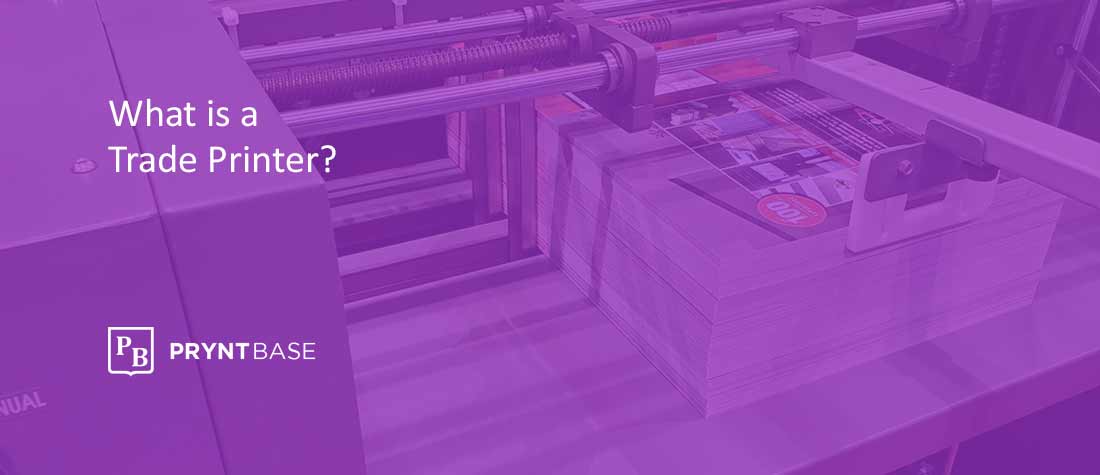What is a Trade Printer? And Why They are Important

What is Trade Printing? And Why Is It Important!
Trade printers or Trade Printing Businesses have carved out a significant niche within the print industry over the past few decades. But many don’t actually know what they are, and are asking the question, “What is a trade printer?”, and why are they so critical to the industry? In this article we go into detail on the specifics around trade printing, its importance, and provide some data related to the trade printing industry.
What is Trade Printing?
So what is a trade printer? A trade printer is a company that offers printing services exclusively to intermediaries, such as print brokers, designers, and other print resellers, rather than directly to the end customer. So trade printers typically don’t widely market their printing services. These intermediaries (or middlemen), in turn, sell the printed materials to their clients. Trade printers do not compete with their clients by marketing directly to end consumers. Instead, they operate behind the scenes, ensuring that the intermediaries receive high-quality printed products at competitive prices.
This is where the name comes from as they sell to the “Trade” and not end users.
The Importance of Trade Printers
Trade printing companies are an extremely important part of the print industry. Here we are sharing a number of the benefits they provide to other print businesses.
Cost Efficiency
Trade printers typically operate at a much higher volume, which allows them to achieve economies of scale. This means lower costs per unit, which can be passed on to intermediaries. For small to medium-sized print brokers and designers, this cost efficiency is invaluable, allowing them to offer competitive pricing to their clients while maintaining healthy profit margins.
Specialization and Expertise
Trade printers are specialists in their field. They invest in state-of-the-art printing technology, equipment and employ skilled professionals who ensure high-quality output. This specialization means that intermediaries can rely on trade printers for superior print quality and innovative printing techniques.
Wide Range of Services
Trade printers offer a comprehensive list of printing services, from offset and digital printing to large format and specialty printing & finishing. This variety enables intermediaries to cater to a broad spectrum of customer needs without having to invest in diverse printing equipment themselves.
Confidentiality and Non-Competition
One of the key aspects of trade printing is the commitment to non-competition. Trade printers do not market their services to end customers, ensuring that intermediaries retain their client base. This confidentiality builds trust and long-term partnerships between trade printers and their clients.
Speed and Efficiency
Trade printers are geared towards high-volume production, which often translates into quicker turnaround times. For intermediaries, this means being able to meet tight deadlines and deliver projects to clients promptly.
Statistics on the Trade Printing Industry
The trade printing industry has shown robust growth and significant market presence. Here are some key statistics that highlight its impact:
Market Size
According to a report by Smithers Pira, the global printing market was valued at around $814 billion in 2022. Trade printing constitutes a substantial portion of this market, driven by the demand from intermediaries who serve various sectors such as marketing, retail, and corporate services.
Growth Rate
The trade printing segment has been growing steadily. Research by IBISWorld indicates that the trade printing services industry in the U.S. has grown at an annualized rate of 2.4% from 2017 to 2022, outpacing some other segments of the printing industry.
Technological Advancements
The adoption of advanced printing technologies is a major trend in the trade printing industry. Digital printing, in particular, has seen significant growth. According to Smithers, the digital print market was worth $141.8 billion in 2020 and is projected to reach $225 billion by 2026, driven largely by trade printers’ investments in digital printing capabilities.
Employment and Economic Impact
The printing industry, including trade printing, is a significant employer. The Printing Industries of America reported that the printing industry employed over 400,000 people in the U.S. alone as of 2021. Trade printers contribute to this employment, offering jobs in production, design, sales, and logistics.
Trade printers play a critical role in the printing industry by providing essential services to intermediaries. Their ability to offer cost-effective, high-quality, and specialized printing services makes them invaluable partners for print brokers, designers, and other resellers. The growth and resilience of the trade printing industry, backed by impressive market statistics, underscore its importance in the broader printing industry. As technology continues to advance and market demands evolve, trade printers will undoubtedly remain a cornerstone of the printing industry, enabling intermediaries to thrive and succeed.
